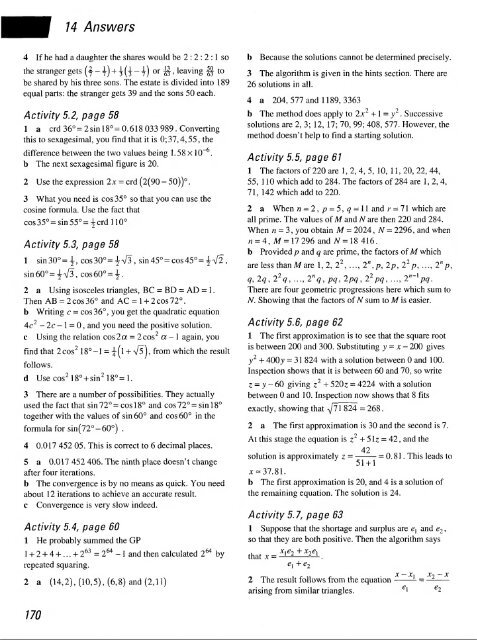history of mathematics - National STEM Centre
history of mathematics - National STEM Centre
history of mathematics - National STEM Centre
You also want an ePaper? Increase the reach of your titles
YUMPU automatically turns print PDFs into web optimized ePapers that Google loves.
14 Answers<br />
4 If he had a daughter the shares would be 2 : 2 : 2 :1 so<br />
the stranger gets (j-j) + }(}-}) or $, leaving |§ to<br />
be shared by his three sons. The estate is divided into 189<br />
equal parts: the stranger gets 39 and the sons 50 each.<br />
Activity 5.2, page 58<br />
1 a crd 36° =2 sin 18° =0.618 033 989. Con verting<br />
this to sexagesimal, you find that it is 0;37,4,55, the<br />
difference between the two values being 1.58x 10"6 .<br />
b The next sexagesimal figure is 20.<br />
2 Use the expression 2x = crd (2(90 - 50))°.<br />
3 What you need is cos 35° so that you can use the<br />
cosine formula. Use the fact that<br />
cos35°=sin55°=^crdllO°<br />
Activity 5.3, page 58<br />
1 sin30 0 =^-,cos30 0 =^V3, sin45° = cos45°= JrV2,<br />
sin60°=^V3, cos60°= {.<br />
2 a Using isosceles triangles, BC = BD = AD = 1.<br />
Then AB = 2 cos 36° and AC = 1 + 2 cos 72°.<br />
b Writing c — cos36°, you get the quadratic equation<br />
4c 2 - 2c -1 = 0, and you need the positive solution.<br />
c Using the relation cos 2a = 2 cos 2 a - 1 again, you<br />
find that 2cos 2 18°-1 = j(l + Vsj, from which the result<br />
follows.<br />
d Usecos 2 18° + sin 2 18°=l.<br />
3 There are a number <strong>of</strong> possibilities. They actually<br />
used the fact that sin 72°= cos 18° and cos72°= sin 18°<br />
together with the values <strong>of</strong> sin 60° and cos 60° in the<br />
formula for sin(72°-60°) .<br />
4 0.017 452 05. This is correct to 6 decimal places.<br />
5 a 0.017 452406. The ninth place doesn't change<br />
after four iterations.<br />
b The convergence is by no means as quick. You need<br />
about 12 iterations to achieve an accurate result.<br />
c Convergence is very slow indeed.<br />
Activity 5.4, page 60<br />
1 He probably summed the GP<br />
1 + 2 + 4 +... + 2 63 = 2 M - 1 and then calculated 2 64 by<br />
repeated squaring.<br />
2 a (14,2), (10,5), (6,8) and (2,11)<br />
170<br />
b Because the solutions cannot be determined precisely.<br />
3 The algorithm is given in the hints section. There are<br />
26 solutions in all.<br />
4 a 204, 577 and 1189, 3363<br />
b The method does apply to 2;c 2 +1 = y2 . Successive<br />
solutions are 2, 3; 12, 17; 70, 99; 408, 577. However, the<br />
method doesn't help to find a starting solution.<br />
Activity 5.5, page 61<br />
1 The factors <strong>of</strong> 220 are 1, 2, 4, 5, 10, 11, 20, 22, 44,<br />
55, 110 which add to 284. The factors <strong>of</strong> 284 are 1, 2,4,<br />
71, 142 which add to 220.<br />
2 a When n = 2, p = 5,
















